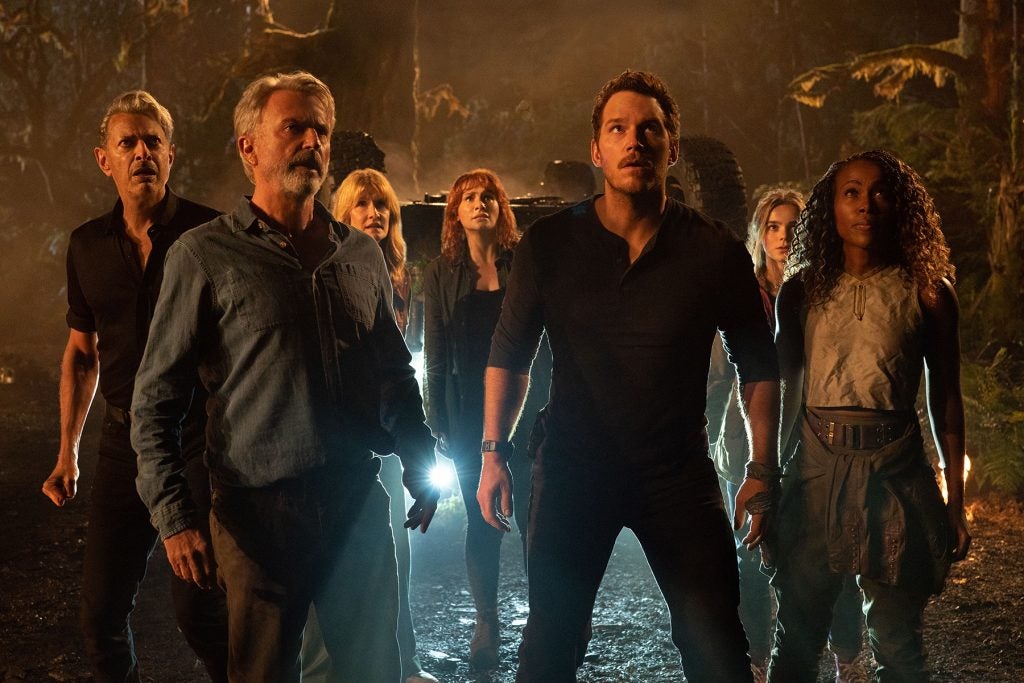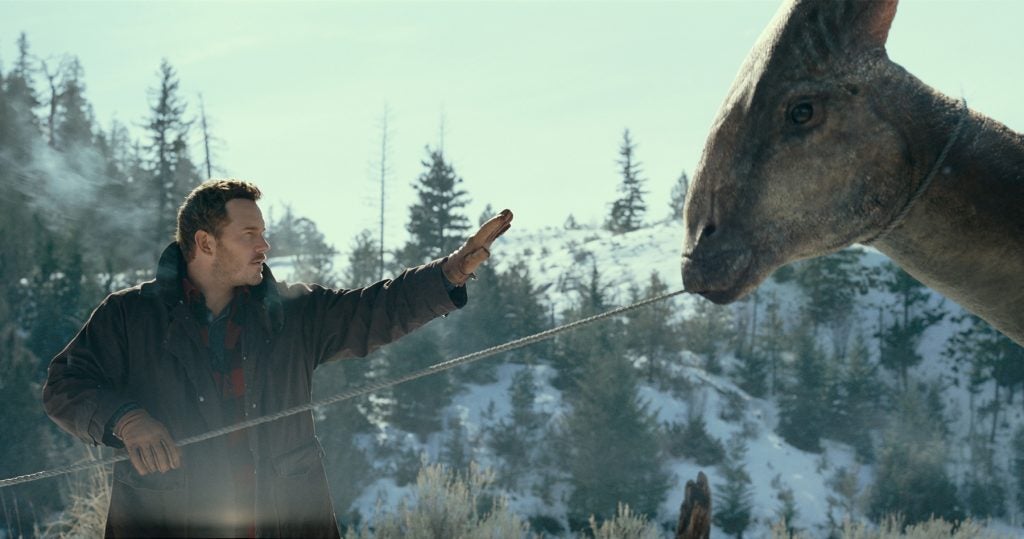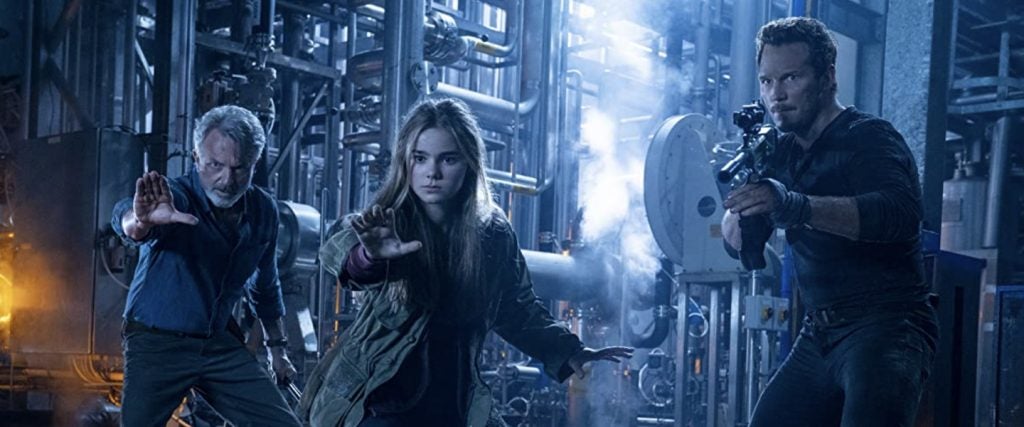I like Laura Dern. I like Sam Neill. I generally like Jeff Goldblum. (Look, I find his shtick a little tiresome occasionally.) But I wouldn’t say I’m someone who has great emotional attachment to the characters they played in Jurassic Park 29 years ago. And yet, I found myself brightening during Jurassic World Dominion whenever they were on screen. It’s not as if they’re especially terrific in this latest sequel — or that their characters significantly add to the story. It’s just that, in comparison to the actual stars of the movie, at least they have a little life to them. Watching Jurassic World Dominion, you won’t just think about how the 1993 blockbuster far surpasses this new film, you’ll notice that the franchise’s original cast easily outperforms Chris Pratt and Bryce Dallas Howard.
This isn’t an isolated incident on the Hollywood landscape. It was back in 2015 that writer and critic Matt Singer coined the term “legacyquel,” now commonly just called a legacy sequel, to define the phenomenon in which we now find ourselves. Forgot reboots and remakes: Legacy sequels, popularized by the recent Star Wars trilogy, dreamed up a new way to endlessly recycle franchises, bringing together a film series’ initial stars with a new generation of characters (played by up-and-coming actors) for fresh, exciting adventures. This way, studios could cater to the fan base while expanding the universe, giving audiences a whole crop of additional heroes to root for — who, just coincidentally, could carry the torch for future installments when the older actors are no longer with us. In an age of Avengers films, which demand you stack the cast with as many protagonists as possible, legacy sequels were a clever gambit to keep people invested in intellectual property forever.
But that’s discussing the trend in pure dollars-and-cents terms. Are any of these legacy sequels actually good? Some are, some aren’t, but with a few exceptions, what they all have in common is the new cast isn’t as dynamic as the original actors, which is an indictment of legacy sequels and, in general, IP-centric films’ endless nostalgia churn. Even the good legacyquels remind you that earlier installments were better. Plus, they set up younger actors to pale in comparison to their aging counterparts. Too often, legacy sequels feel parasitically attached to better, older films.

Jurassic World Dominion follows Jurassic World: Fallen Kingdom, which ended with a disturbing new normal: Humans must now share Earth with dinosaurs. Putting aside a major problem with Jurassic World Dominion, which is that it doesn’t explore that scenario nearly compellingly enough, this sequel once again insists that we care about the love story between Owen Grady (Pratt) and Claire Dearing (Howard), which has never, ever been worth caring about. Nonetheless, we dutifully go through the motions of watching them as they try to rescue Maisie (Isabella Sermon), the young woman who, it turns out, was a clone. (This is something we learned about in Fallen Kingdom. Don’t worry, it’s not worth remembering.) Their saga to save their surrogate daughter will bring them to Biosyn Valley, a haven in the Colorado mountains that’s become a sanctuary for dinosaurs, overseen by Biosyn CEO Lewis Dodgson (Campbell Scott), who is most assuredly evil.
But where the first two films in this new trilogy would have centered on just this couple, Jurassic World Dominion swells the cast of characters, and soon enough we’re reacquainted with our Jurassic Park heroes. Ian Malcolm (Goldblum) is doing some work at Biosyn, although he thinks Lewis’ biotech company is imperiling the planet. Meanwhile, Ellie Sattler (Dern) has uncovered a sudden rash of terrifyingly mutated locust swarms that are devastating crops in the Midwest, reaching out to former flame Alan Grant (Neill), who’s out digging up old fossils, to help her determine their origin. (I’ll just tell you: Biosyn is behind it all.) Soon enough, this former couple will also make its way to Biosyn Valley, running into Ian and, eventually, meeting Owen and Claire. Oh man, two generations of Jurassic characters teaming up — can you imagine the possibilities?!?
This, of course, is the strategy behind every legacy sequel, a new way to apply the “more is more” attitude to blockbusters. (“Does your movie have as many characters as ours does???”) And while I confess I felt a slight stirring at the sight of, say, Pratt and Goldblum hanging out together — like dopey Jurassic fanfiction brought to life — it became apparent quickly that I was drawn more to the older actors. Just like I was with the recent Star Wars trilogy. Or The Matrix: Resurrections. Sometimes, the younger cast is better than (or at least equal to) the original stars — Star Trek Generations or Creed come to mind — but more often than not, you get a situation like the terrible Ghostbusters: Afterlife, which carts out the original cast, who don’t seem all that engaged and yet somehow still seem more energetic than the new characters.
To be fair, some of that preference could be the scourge of nostalgia, which tricks you into thinking that your youth (and anything you saw back then) is automatically better than the present. But I also think it’s a byproduct of filmmakers trying to create new characters who have to live up to their iconic forebears. Take the recent Star Wars trilogy: It’s not as if Adam Driver and Oscar Isaac weren’t already celebrated actors before signing up for the franchise. (Daisy Ridley was less-known, as was John Boyega, who had nonetheless enjoyed a breakout success with the cult horror-comedy Attack the Block.) But those newer stars struggled to have the same presence as Carrie Fisher, Harrison Ford and Mark Hamill. Part of it was that they had to contend with their older costars’ decades of cultural ubiquitousness as those mythic heroes. But it was also partly because, as legacy sequels often discover, it’s actually pretty hard to create iconic characters.
With Isaac’s Poe essentially a new model Han Solo — and Driver’s Kylo Ren actively trying to escape Darth Vader’s shadow — the new movies subconsciously signaled the fact that they were echoing the original films, placing them in the superior position. The majority of the big emotional moments in the new trilogy came from Leia, Han and Luke — ultimately, they were the ones we were meant to care about the most.
This imbalance isn’t quite as clear-cut with Jurassic World Dominion, a franchise that’s never been that invested in its humans. (Let’s be honest: The dinosaurs have always been what matters.) But the simple, Jaws-like terror of the original Jurassic Park, buoyed by the three actors’ likable rapport, helped make those characters memorable. You felt like you’d gone through something with Ian and his chums, whereas Owen and Claire have been nothing more than attractive dullards from the start, their oil-and-water animosity in Jurassic World meant to lead to romantic sparks. (Spoiler Alert: Such sparks did not occur.) As a result, the recent films have dragged, burdened by boring main characters.
Put it this way: Not that long ago, people actually got excited about Pratt becoming a movie star — well, that enthusiasm ceased once they saw him in Jurassic World, where he did a sub-Indiana Jones impression that suggested he didn’t have the charisma to be an action hero. (For those who argue that he’s good in the Guardians of the Galaxy films, I agree with you — and also think he shrinks from view whenever Star-Lord is alongside one of the more famous Avengers.)

So I really shouldn’t have been surprised that Dern, Goldblum and Neill end up stealing Jurassic World Dominion. But whether it’s this film or other legacy sequels, I think the disparity in audience interest between the new and old cast is also indicative of a phenomenon we don’t talk about enough, which is that it’s often quite nice to see actors age on screen. Dern, Goldblum and Neill don’t look like they did almost 30 years ago, and while they’ve kept working steadily, they haven’t been together in a movie for a very long time, and wrinkles and gray hair lend them a gravitas that their younger cohorts simply can’t match. Like the rest of the planet, Hollywood freaks out about aging, especially when it comes to women, but the one ironic positive about legacy sequels is that they force studios to put “old” actors into modern blockbusters. As a result, they allow us a rare instance to see 70-something-year-old men and 50-something-year-old women on screen, even if it’s in a so-so movie like Jurassic World Dominion.
I didn’t love Top Gun: Maverick, but as a friend pointed out, one of the things that distinguishes it from a lot of legacy sequels is that it has no delusions about who the main character is. All those new TOPGUN recruits? There’s no sense that the franchise is passing the torch to them. Tom Cruise was the star of Top Gun, he’s the star of Top Gun: Maverick, and he will be the star of any Top Gun sequel to come. In a way, there’s a refreshing honesty about that arrangement: Other franchises go through the motions of creating new protagonists for their musty properties, but they know that we’re really just there for the original characters.
Jurassic World Dominion figures that you’ll buy a ticket to see Ellie, Ian and Alan one last time, and certainly lots of fans will. But they may also be voting with their movie ticket in another way: “We like the people that were once in this franchise, and we can’t stand the new folks you’ve decided to foist upon us since.”
What kind of legacy is that?

